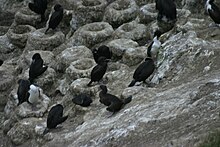Otago shag
| Otago shag | |
|---|---|

| |
| Scientific classification | |
| Domain: | Eukaryota |
| Kingdom: | Animalia |
| Phylum: | Chordata |
| Class: | Aves |
| Order: | Suliformes |
| Family: | Phalacrocoracidae |
| Genus: | Leucocarbo |
| Species: | L. chalconotus
|
| Binomial name | |
| Leucocarbo chalconotus (Gray, 1845)
| |
| Synonyms | |
|
Phalacrocorax chalconotus | |
The Otago shag (Leucocarbo chalconotus) (Māori: Matapo),[2] together with the Foveaux shag formerly known as the Stewart Island shag and in its dark phase as the bronze shag, is a species of shag now found only in coastal Otago, New Zealand.
Description
[edit]
The species is dimorphic, with two plumages. Roughly one quarter of the individuals (a smaller percentage than in Foveaux shag) are pied, with dark and white feathers, and the rest, known as bronze shags, are dark all over.[3] Both morphs breed together. These large, chunky birds are about 70 cm long and weigh about 2–3 kg, slightly larger than the closely related Foveaux shag.
Otago shags vary in their facial ornamentation in the breeding season. Roughly half of breeding individuals have dark orange papillae on their face (as in Foveaux shag), while the other half have small bright orange caruncles above the base of the bill instead. Gular pouch colour in the breeding season also varies, from bright orange (as in Foveaux shag) to dark orange to purple.[4]
Classification
[edit]Until 2016, Otago shags and the closely related shags living around Stewart Island and Foveaux Strait were considered to be a single species, called the Stewart Island shag.[4] Mitochondrial DNA suggests Otago shags are actually more closely related to Chatham shags (Leucocarbo onslowi), and osteological and genetic differences supported separating off Foveaux shags as a distinct species, L. stewarti. Foveaux and Otago shags probably diverged when populations were split up by lower sea levels in the Pleistocene, and the Chatham Islands were subsequently colonised by shags from Otago.[4] Other taxonomists have kept the Otago shag and the Foveaux shag conspecific.
A recent taxonomic revision argues that Leucocarbo is a distinct genus, which would contain amongst other species the Otago, Foveaux, and Chatham shags.[5] Others place it in the genus Phalacrocorax.
Distribution and conservation
[edit]Archaeological evidence shows that Otago shags were formerly found along the entire east coast of the South Island up to Marlborough, but when humans arrived the population was devastated, reduced by 99 percent within 100 years with a corresponding loss of genetic diversity.[6] It became restricted to the rocky offshore islets off the Otago Peninsula, and has scarcely recovered since that time.[7] There are less than 2500 Otago shags remaining, but they can be seen at Otago Harbour, as far north as Oamaru, and as far south as the Catlins.[8] Restricted to a small area, and having little or no genetic variation, they require conservation efforts tailored to these extinction risk factors; this could include reintroduction to part of their former range.[4]

Otago shags breed colonially from May to September, making raised cup nests out of organic material and guano on islands and sea cliffs. Colonies are large enough to be strikingly visible, and are used year after year. One notable colony is on the northern shore of Taiaroa Head, at the mouth of the Otago Harbour. They feed in coastal waters less than 30 m deep and are rarely if ever seen inland or far out to sea.[9]
References
[edit]- ^ BirdLife International (2018). "Leucocarbo chalconotus". IUCN Red List of Threatened Species. 2018: e.T22696853A133556225. doi:10.2305/IUCN.UK.2018-2.RLTS.T22696853A133556225.en. Retrieved 18 November 2021.
- ^ "Otago shag | Matapo | New Zealand Birds Online". nzbirdsonline.org.nz. Retrieved 26 November 2023.
- ^ Rawlence, Nicolas J.; Till, Charlotte E.; Scofield, R. Paul; Tennyson, Alan J. D.; Collins, Catherine J.; Lalas, Chris; Loh, Graeme; Matisoo-Smith, Elizabeth; Waters, Jonathan M. (2014). "Strong Phylogeographic Structure in a Sedentary Seabird, the Stewart Island Shag (Leucocarbo chalconotus)". PLOS ONE. 9 (3): e90769. Bibcode:2014PLoSO...990769R. doi:10.1371/journal.pone.0090769. PMC 3948693. PMID 24614677.
- ^ a b c d Rawlence, Nicolas J.; Scofield, R. Paul; Spencer, Hamish G.; Lalas, Chris; Easton, Luke J.; Tennyson, Alan J.D.; Adams, Mark; Pasquet, Eric; Fraser, Cody; Waters, Jonathan M.; Kennedy, Martyn (2016). "Genetic and morphological evidence for two species of Leucocarbo shag (Aves, Pelecaniformes, Phalacrocoracidae) from southern South Island of New Zealand". Zoological Journal of the Linnean Society. 177 (3): 676–694. doi:10.1111/zoj.12376.
- ^ Kennedy, Martyn; Spencer, Hamish G. (2014). "Classification of the cormorants of the world". Molecular Phylogenetics and Evolution. 79: 249–257. doi:10.1016/j.ympev.2014.06.020. PMID 24994028.
- ^ Morton, Jamie (17 February 2016). "Meet our 'newest' endangered bird species". The New Zealand Herald. NZME. Retrieved 2 March 2016.
- ^ "New Otago shag species discovered". 39 Dunedin Television. 18 February 2016. Retrieved 2 March 2016.
- ^ Chamberlain, Rhys (18 February 2016). "Otago shag new species". Otago Daily Times. Retrieved 2 March 2016.
- ^ Heather, Barrie; Robertson, Hugh (2015). The Field Guide to the Birds of New Zealand. New Zealand: Penguin. p. 290. ISBN 978-0-143-57092-9.
External links
[edit]- Otago shag discussed on RadioNZ Critter of the Week, 4 March 2016

